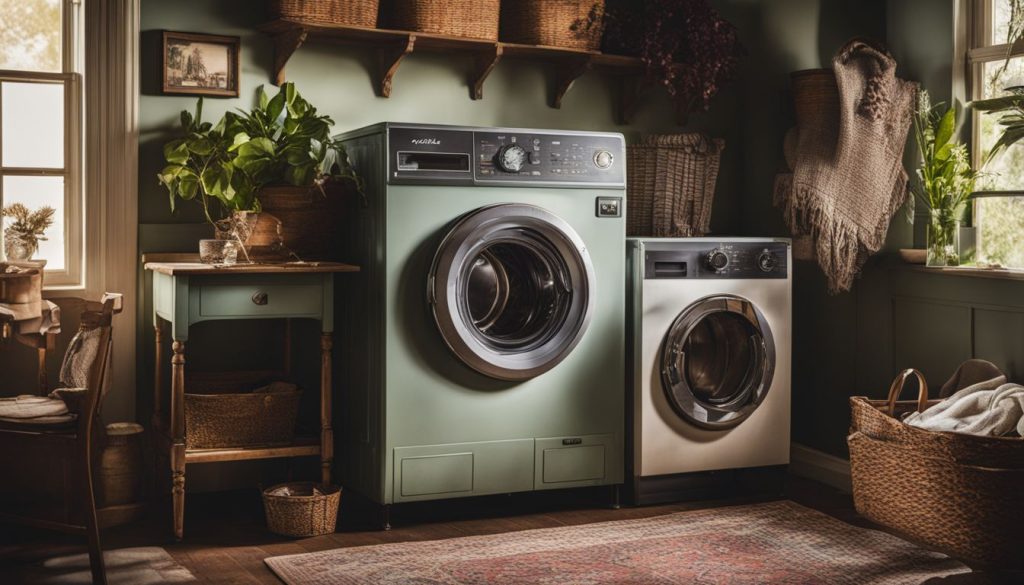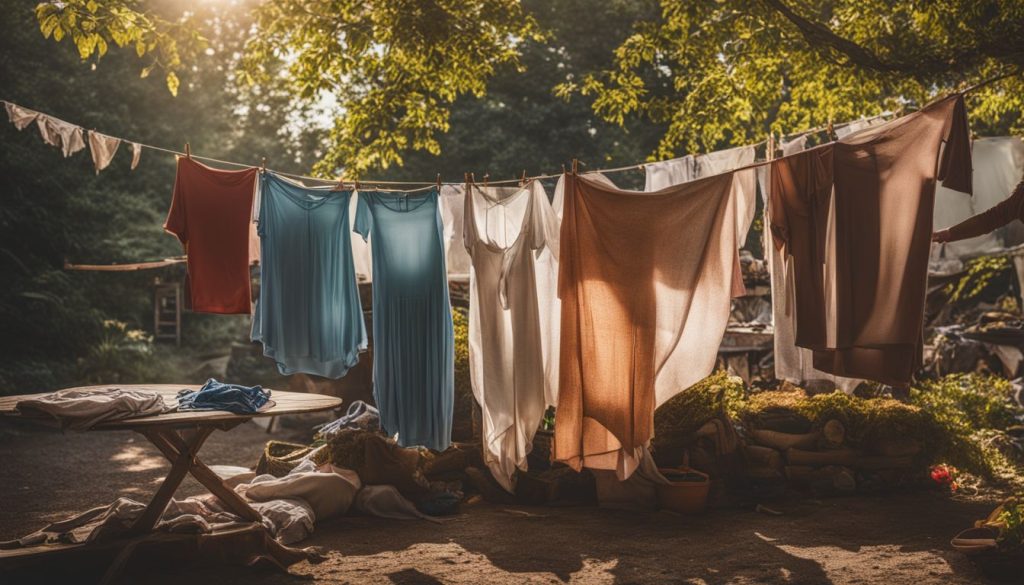
Have you ever worried about how to clean “dry clean only” garments without damaging them? It turns out there’s a method called professional wet cleaning that safely cleans these delicate items.
This blog post will unveil the wonders of wet cleaning, showcasing its benefits and why it trumps traditional methods. Dive in for a refreshing take on garment care!
Key Takeaways
- Professional wet cleaning uses water and biodegradable detergents instead of harsh chemical solvents, making it a safer and more eco-friendly garment care option.
- It is particularly suitable for delicate fabrics that can be damaged by traditional dry cleaning methods; the process effectively removes stains while being gentle on clothing.
- Wet cleaning promotes better air and water quality, reduces exposure to toxic chemicals, conserves energy, and is less likely to cause allergic reactions than conventional dry cleaning.
- The method has become more accessible as its popularity increases with both professional cleaners and consumers seeking sustainable alternatives for laundry services.
- Despite the use of water, wet cleaning systems are designed to optimize water usage and often result in garments feeling softer with a pleasant scent compared to those treated with dry cleaning.
What is Wet Cleaning?
Wet cleaning is a gentle yet effective alternative to traditional dry cleaning, utilizing water and specialized detergents to clean clothes without the harsh chemicals. This eco-friendly approach not only preserves the quality of garments but also promotes a healthier environment, making it an increasingly popular choice among professional garment cleaners.
Definition and Explanation
Professional wet cleaning is an ecofriendly approach to laundering clothes that’s gentle on fabrics and kind to the environment. Instead of relying on harsh chemical solvents used in traditional dry cleaning, this water-based method employs specialized detergents and technology to safely clean all types of garments, even delicate ones.
Tailored for various textiles, it promises nontoxic dry cleaning without compromising on effectiveness.
This sustainable garment-cleaning process uses minimal water and carefully chosen soaps that are less aggressive than conventional options. The technique meticulously controls temperature, moisture levels, and agitation to ensure a deep clean that maintains the integrity of the fabric.
It’s not just about being environmentally friendly; professional wet cleaning services also deliver impeccable results with every garment they handle – offering peace of mind for both your wardrobe and the planet.
How it Differs From Traditional Dry Cleaning
Professional wet cleaning marks a significant departure from traditional dry cleaning practices by shunning the use of chemical solvents. Instead, it harnesses water-based solutions that are gentler on fabrics and the planet.
This green cleaning technique mirrors home laundry methods but elevates them with advanced equipment and specialized detergents designed to handle delicate garments with care. Wet cleaners also utilize technology that precisely controls water levels, temperature, and agitation to ensure thorough yet safe garment cleaning.
Unlike its older cousin dry cleaning, which often relies on perchloroethylene—a solvent linked to environmental and health concerns—wet cleaning opts for eco-friendly alternatives.
These nontoxic approaches not only reduce potential harm to workers handling clothes but also prevent chemical residues from lingering in your wardrobe or being released into the ecosystem.
The philosophy behind sustainable cleaning is simple: clean clothes shouldn’t come at an unreasonable cost to our well-being or surroundings.
Advantages and Benefits
Wet cleaning stands as a champion of eco-friendly cleaning, offering a myriad of benefits that traditional methods can’t match. It merges the gentle touch needed for natural fabric care with the power to get clothes spotlessly clean.
- Preserves air and water quality: Wet cleaning slashes the risk of air and water pollution by steering clear of harmful chemicals, making it an environmentally safe dry cleaning alternative.
- Provides softer clothes with a fresh scent: Not only does wet cleaning leave garments feeling incredibly soft, but it also imparts them with a pleasant smell without any chemical odors.
- Conserves water smartly: Despite its name, wet cleaning is a waterefficient laundry technique. It optimizes water usage better than conventional laundry practices.
- Protects your health and the planet’s: With its nontoxic cleaning approach, wet cleaning ensures that neither you nor the environment suffers from exposure to hazardous substances.
- Works wonders on various textiles: Whether it’s silk or wool, wet cleaning is known for being safe and effective across different types of clothing without causing damage or shrinkage.
- Cuts down on energy consumption: This sustainable cleaning method often requires less energy than traditional dry cleaning processes because it operates at lower temperatures.
- Offers peace of mind for sensitive skin: For those with allergies or sensitivity to chemicals, wet cleaning is a godsend, ensuring no irritants come into contact with skin through cleaned fabrics.
The History and Process of Wet Cleaning
Tracing its roots back to the evolution of garment care, professional wet cleaning merges traditional techniques with modern technology to gently cleanse textiles. This method unfolds through a meticulous sequence where specialized equipment and nontoxic detergents ensure garments emerge impeccably clean without harming delicate fabrics or the environment.
How Wet Cleaning Originated
Wet cleaning took shape in the hands of skilled dry cleaners as a last resort, when traditional cleaning techniques hit a wall. It was a novel approach, relying on water-based methods instead of harsh chemicals to treat delicate fabrics and challenging stains.
These pioneers would only proceed with wet cleaning after discussing it with clients, who had to understand that this method carried certain risks due to the lack of established practices.
Gradually, this alternative cleaning method evolved beyond an experimental technique into a refined process. Its origins reflect a desire for gentler solutions and showcase the industry’s adaptability in response to customer needs and environmental considerations.
As wet cleaning proved its worth by safely reviving garments without toxic solvents, it started transforming from an obscure backup plan into standard practice among forward-thinking professionals.
The Steps Involved in the Process
Wet cleaning is a modern method that combines technology with eco-friendly practices. It transforms how we care for our clothes through a meticulous series of steps.
- Initially, professionals inspect garments to identify fabric types and stains, ensuring the correct treatment.
- They then pre – treat any spots or areas requiring special attention using biodegradable cleaning products.
- Next, clothing goes into advanced cleaning equipment specially designed for wet cleaning procedures.
- The machine uses water and environmentally friendly detergents in a gentle cycle that preserves the integrity of the fabrics.
- After the wash, professionals use state-of-the-art dryers or air-drying techniques suited for each garment type.
- Post – drying, items are finished with specialized ironing and pressing equipment that adds crispness without harm.
- Throughout this process, operators leverage their proper training in wet cleaning to ensure optimal results safely.
Requirements for Proper Wet Cleaning
Mastering the art of wet cleaning goes beyond just adding water to fabrics. It demands a keen understanding and the right approach from start to finish. Trained professionals must have a thorough grasp on how different materials react to water-based solutions, necessitating a comprehensive knowledge base.
They also need advanced equipment designed for precise control over moisture, temperature, and agitation—factors crucial in preserving garment quality during cleaning.
Equally important are the supplies; gentle yet effective detergents and spot cleaners that can tackle stains while maintaining fabric integrity form the cornerstone of any successful wet clean operation.
Adhering strictly to industry guidelines ensures each piece comes out looking its best without compromising environmental or health standards. Implementing these methods with an unwavering commitment sets apart top-notch providers in this ever-evolving sector of garment care.
Wet Cleaning vs. Dry Cleaning
Let’s look into the distinctions between these two garment-cleansing heavyweights, uncovering which method might just revolutionize your approach to fabric care and maintenance.
Comparison of Methods and Techniques
When it comes to freshening up our clothes, the methods we choose can have significant implications for the quality of cleaning and environmental impact. Let’s take a closer look at how wet cleaning stacks up against dry cleaning in terms of methods and techniques.
| Aspect | Wet Cleaning | Dry Cleaning |
| Cleaning Solvent | Uses water and biodegradable detergents | Relies on chemical solvents like perchloroethylene |
| Environmental Impact | More eco-friendly; reduces toxic waste | Potentially harmful to the environment due to chemical use |
| Cleaning Quality | Often results in a better quality clean | Effective on grease and oil but can be harsh on fabrics |
| Fabric Safety | Generally safer for a wide range of fabrics | Can cause damage to delicate fabrics over time |
| Health Considerations | Lower risk of allergic reactions due to non-toxic substances | Use of chemicals poses potential health risks |
| Process | Similar to at-home laundry with advanced equipment | Requires specialized machinery and expertise |
| Water Usage | Efficient water use with modern machines | No water used, but chemical waste must be managed |
| Availability | Becoming more widely available | Wide availability; traditional method |
| Cost | Competitive pricing; may vary by location | Can be more expensive due to chemical usage and disposal |
Comparing wet cleaning with dry cleaning reveals significant differences that can influence your choice. Wet cleaning’s gentle approach ensures that your garments are not only clean but are cared for in a way that prolongs their life. It’s a method that combines efficacy with responsibility, embracing advances in technology to deliver an eco-friendlier solution to garment care.
Pros and Cons of Wet Cleaning
Wet cleaning offers an innovative approach to garment care that blends environmental responsibility with fabric sensitivity. As customers become more conscious of their ecological footprint, they often weigh the advantages and disadvantages of wet cleaning.
- Environmentally Friendly: Wet cleaning stands out as an eco-friendly alternative to traditional dry cleaning. It avoids harsh chemical solvents, making it a nontoxic and green cleaning method.
- Gentle on Clothes: This process is gentle on garments, reducing wear and tear in comparison to dry cleaning, which promotes sustainable clothing care.
- Health Benefits: Choosing wet cleaning means less exposure to toxic chemicals for both customers and workers, leading to a healthier environment.
- Water Conservation: Despite using water, wet cleaning systems are designed to use less water than standard laundry methods, contributing positively to water conservation efforts.
- Safe for Various Fabrics: Wet cleaning’s tailored detergents and conditioners can safely clean a wide range of fabrics without damaging them.
- Potential Water Waste: While it uses less water than traditional laundry methods, there’s still potential for water waste if not managed correctly.
- Requires Specialized Equipment: Not all cleaners have the specialized equipment needed for wet cleaning, which can make it less accessible in some areas.
- Expertise Needed: Proper wet cleaning requires trained professionals who understand how to handle delicate fabrics with this method.
- Availability Issues: Although growing in popularity, wet cleaning services may not be as widely available as conventional dry cleaners.
- Hygienic Concerns in Food Industry: In contexts such as the food industry where hygiene is paramount, there are concerns about whether wet cleaning can meet sanitation standards without chemical solvents.
Pros and Cons of Dry Cleaning
Dry cleaning has been the go-to method for preserving and refreshing clothes that are labeled “dry clean only.” It’s a process that involves specific techniques and chemicals, but it’s important to weigh its advantages and disadvantages.
- Superior Stain Removal: Dry cleaning excels at removing oil and grease-based stains from fabrics without causing damage.
- Less Abrasive: The process is less harsh on clothing than traditional washing, which can help garments maintain their new appearance over time.
- Convenient for Delicate Fabrics: It safely cleans sensitive materials like silk, wool, and velvet by avoiding water-induced shrinkage or distortion.
- Professional Finishing Touches: Clothing often comes back pressed, wrinkle-free, and ready to wear with a professional look that’s hard to achieve at home.
- Effective in Refreshing Garments: Without using water, dry cleaning refreshes clothing by removing odors and giving them a fresh feel.
- Chemical Usage: This method relies on chemical solvents, such as perchloroethylene (perc), which can pose environmental risks and potential health hazards.
- Expensive Over Time: Regular reliance on dry cleaning services can become costly due to pricing per item cleaned.
- Potential for Chemical Residue: Clothes might retain traces of chemicals used during the process. This can be concerning for individuals with sensitive skin or allergies.
- Risk of Fade and Damage: Despite being gentle on clothes, some garments may fade or get damaged due to repeated exposure to chemicals over time.
- Environmental Impact: The use of non-biodegradable chemical solvents contributes negatively to our ecosystem, making it less eco-friendly than other methods like water-based wet cleaning.
Why Choose Wet Cleaning?
When considering the care of your garments and the impact on health and environment, wet cleaning emerges as an innovative solution. This water-based method not only promises gentle yet effective cleansing for a variety of fabrics but also aligns with green practices that are becoming increasingly vital in today’s world.
Health and Environmental Benefits
Wet cleaning stands out as a champion of eco-friendly cleaning. It sidesteps the environmental pitfalls associated with traditional dry cleaning methods by avoiding toxic chemicals and reducing waste.
This nontoxic cleaning approach relies on water—a renewable resource—and biodegradable detergents that are gentle on the planet. With wet cleaning, clothes are not only impeccably clean but also free from any chemical residue that could harm your health or the environment.
Energy-efficient cleaning is another hallmark of wet cleaning systems; they consume less power and water than their conventional counterparts, making them a sustainable choice for conscious consumers.
By eliminating hazardous substances such as VOCs (volatile organic compounds), wet cleaning ensures a safe working environment for employees while also safeguarding customers’ well-being.
This method reflects an evolution towards nonhazardous and waterefficient practices in garment care—conscientiously preserving resources and protecting health without compromising quality.
Safe and Effective for Different Types of Clothing
Wet cleaning stands out as a game-changer for garment care, especially when it comes to delicate fabrics that could suffer damage from conventional washing methods. This gentle cleaning approach thoroughly removes stains and odors without the harshness of traditional dry cleaning chemicals, making it suitable for everything from silk blouses and wool suits to intricate bridal wear and beaded gowns.
Because the process is nontoxic, your favorite garments get expertly cleaned with minimal risk of fading or texture alteration.
Garments treated with wet cleaning come out fresh, vibrant, and often feel softer to the touch compared to other methods. It’s an ecofriendly choice not only for your clothes but also for the environment.
Whether you’ve spilled wine on a silk dress or need regular laundering for cotton shirts, wet cleaning technology safely revitalizes various textiles without compromising fabric integrity or color.
With its ability to effectively clean different types of clothing, selecting this water-based method means opting for safe laundering every time.
Availability and Cost
Choosing ecofriendly laundry methods like professional wet cleaning doesn’t just benefit your garments; it can also be gentle on your wallet. This water-based cleaning technique skimps on the expensive chemical solvents that dry cleaners typically use, potentially lowering overall costs.
More and more local cleaners are offering this nontoxic, environmentally friendly cleaning option, making it accessible for those who prioritize sustainable dry cleaning alternatives.
Finding a cleaner that specializes in affordable cleaning options such as wet cleaning is getting easier. Dependable Cleaners offers these services alongside their conventional offerings.
Consumers have the power to support green practices by opting for gentler fabric care that’s kinder to both clothing and nature – all without breaking the bank. As demand increases, the availability of budget-friendly, chemical-free cleaning choices is sure to grow, empowering you to make greener decisions comfortably.
Conclusion
Embrace the tide of change in garment care with professional wet cleaning. This method marries innovation with sustainability, safeguarding your delicate fabrics while protecting our planet.
Trust in the gentle power of water and specialized detergents to revitalize your “dry clean only” garments without harsh chemicals. Witness a fresh, eco-friendly approach to keeping your wardrobe impeccable.
Let professional wet cleaning be your choice for fabric-friendly, green garment care.
FAQs
1. What is professional wet cleaning?
Professional wet cleaning is an eco-friendly method used by cleaners to wash delicate fabrics with water and specialized detergents.
2. Is professional wet cleaning safe for all types of clothes?
Yes, professional wet cleaning is safe for most types of clothing, including those typically labeled as “dry clean only.”
3. Does professional wet cleaning use harsh chemicals?
No, professional wet cleaning does not use the harsh chemicals commonly found in traditional dry-cleaning processes.
4. Can professional wet cleaning remove tough stains?
Yes, expertly performed professional wet cleaning can effectively tackle and remove tough stains from garments.
5. Will my clothes shrink or get damaged with professional wet cleaning?
No, when done correctly by trained technicians, professional wet cleaning minimizes the risk of shrinking or damaging your garments.



